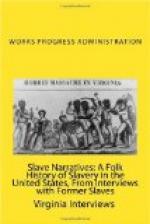The cabins that the slaves occupied were located on one section of the plantation known as the “quarters.” These dwellings were crude one-roomed structures usually made from logs. In order to keep the weather out mud was used to close the openings between the logs. In most instances the furnishing of a cabin was complete after a bed, a bench (both of which were made by the slave) and a few cooking utensils had been placed in it. As there were no stoves for slave use all cooking was done at the fireplace, which, like the chimney, was made of mud and stones. One or two openings served the purpose of windows, and shutters were used instead of glass. The mattresses on which they slept were made from hay, grass or straw. When a light was needed a tallow candle or a pine knot was lighted.
Absolute cleanliness was required at all times and the floors, if they were made of wood, had to be swept and scrubbed often. In addition to the private dwellings there was one large house where all children not old enough to go to the field were kept. One or two of the older women took charge of them, seeing that they had a sufficient amount of corn bread, vegetables and milk each day. All were fed from a trough like little pigs.
These old women were also responsible for the care of the sick. When asked if a doctor was employed, Mr. Eason replied that one had to be mighty sick to have the services of a doctor. The usual treatment for sick slaves was castor oil, which was given in large doses, salts and a type of pill known as “hippocat.” (ipecac)
Although they were not permitted any formal type of learning religious worship it was not denied them. Each Sunday Mr. Ormond required that all his slaves attend church. All went to the white church where they sat in back and listened to the sermon of a white preacher. Mr. Eason says that the slaves believed in all kinds of and every conceivable type of signs. Their superstitions usually had to do with methods of conjure.
A preacher was never used to perform a wedding ceremony on the Ormond plantation. After the man told the master about the woman of his choice and she had been called and had agreed to the plan, all that was necessary was for the couple to join hands and jump over a broom which had been placed on the ground.
Mr. Ormond permitted few if any celebrations or frolics to take place on his farm. When he did grant this privilege his slaves were permitted to invite their friends who of course had to get a “pass” from their respective masters. They, too, were required to secure a pass from Mr. Ormond if they wanted to visit off the premises. If caught by the “Paddle Rollers” (Patrollers) without this pass they were soundly whipped and then taken to their master.
At the beginning of the Civil War all the slaves talked among themselves concerning the possible outcome of the war. However, they never let the master or the overseer hear them because it meant a whipping.




